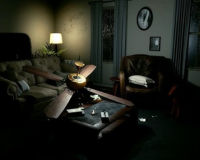
Advertisement
Overcome Your Fears – Caretaker
Overcome Your Fears – Caretaker tells the story of Steve Jackson, a young man who accepts a simple job while his friends are away. The task is clear: take care of a house, follow a few instructions, and keep everything in order until they return. What appears to be routine soon begins to shift. The more Steve walks through the rooms, the more he notices small inconsistencies — a sound that should not be there, a light that does not behave as expected. The house becomes an environment that watches back, turning the act of caretaking into quiet investigation.
Space and Perception
The entire game takes place inside a single building, but its structure constantly changes. Every room is connected, yet transitions between them alter how the player understands the layout. There is no map or external guidance; navigation depends on attention and memory. The lighting and sound design guide behavior, not through direction but through suggestion. Each decision — to turn, to move, to stay — carries a sense of uncertainty that defines the experience. The boundaries of safety shift slowly, asking players to question what part of the house still follows the rules.
Interaction and Function
Overcome Your Fears – Caretaker keeps its mechanics minimal. There are no weapons, no inventory screens, and no traditional objectives. Progress depends on observation and reaction.
- Move with W, A, S, D
- Run with Shift
- Crouch with C
- Interact or examine with E
- Drop objects with G
The simplicity of the controls makes every action deliberate. Walking across a hallway or picking up an item becomes an act of focus. What you interact with may trigger changes elsewhere in the environment, and the game never explains these shifts directly. This absence of instruction keeps the player alert, transforming normal motion into an act of discovery.
Narrative Approach
The story unfolds through experience rather than dialogue. Steve’s presence in the house is never fully explained, and the events that occur seem to follow an internal pattern that the player must interpret. Each new interaction adjusts the atmosphere slightly, as if the house itself were responding to curiosity. The narrative avoids clear resolution, letting questions replace answers. Instead of telling the player what to fear, the game allows them to find unease in repetition and small distortions.
Development and Continuation
Overcome Your Fears – Caretaker is a demo version that introduces the framework of a larger concept. It offers a short but complete loop that focuses on mood and space awareness. Future updates are planned to expand the narrative and add new environmental interactions. The project examines the relationship between duty and uncertainty — how simple responsibility can turn into self-confrontation. In doing so, it treats fear not as an external presence but as something built quietly through repetition, attention, and change that refuses to explain itself.














































































